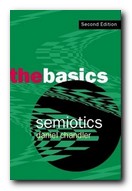Semiotics is ‘the study of signs’ – but what constitutes a ‘sign’? Basically, it can be anything. Its significance will be determined by the context in which it appears and the way in which it is interpreted. The colour red can suggest passion, danger, or heat, depending on where it occurs and who perceives it. Daniel Chandler’s introduction to the subject explains the history and the various strands of the subject in everyday language, using up-to-date examples.
 Basically, his account covers the development of these ideas from the nineteenth-century Swiss linguist Saussure, to post-modern cultural theorists of the present day. Semiotics is a subject which can hardly escape the dominance of language as the most developed system of signs. This is because language has what he calls ‘double articulation’. What this means is that small units (words) can be signs, but they can be combined indefinitely with each other to form other, bigger, or more complex signs. However, the theory leads effortlessly into considerations of linguistics, philosophy, and critical theory, as well as cultural media such as television, photography, literature, cinema, and even academic writing. This is in addition to the more obvious day-to-day sign systems of facial expressions, food, clothing, and social gestures.
Basically, his account covers the development of these ideas from the nineteenth-century Swiss linguist Saussure, to post-modern cultural theorists of the present day. Semiotics is a subject which can hardly escape the dominance of language as the most developed system of signs. This is because language has what he calls ‘double articulation’. What this means is that small units (words) can be signs, but they can be combined indefinitely with each other to form other, bigger, or more complex signs. However, the theory leads effortlessly into considerations of linguistics, philosophy, and critical theory, as well as cultural media such as television, photography, literature, cinema, and even academic writing. This is in addition to the more obvious day-to-day sign systems of facial expressions, food, clothing, and social gestures.
His guidance through this multi-discipline maze is thoughtful and clear, and even though you have to be prepared to dip your toes into the waters of critical theory, he has a reassuring manner which makes it a pleasant intellectual experience.
I enjoyed his chapters on metaphor, irony, and codes – though a few more examples of how the theory could be applied would be useful. It would also be interesting to consider why something deprecated in one code (switching point of view in film, for instance) is permitted in another, such as narrative fiction.
However, he summarises his exposition with a useful chapter outlining the strengths and limitations of semiotics as an analytic tool. I was slightly surprised he didn’t include more comment on the Internet as a cultural medium, because this book has its origins as a well-established web site where he has been posting help for his students in the last few years.
Semiotic theory claims that it can reveal the codes and conventions shaping what we might otherwise think of as ‘natural’, which makes it a powerful tool for analysing all forms of culture and human communication. This an excellent basic introduction to the subject, with a good glossary, an index, and a list of further reading.
© Roy Johnson 2007
Daniel Chandler, Semiotics: The Basics, London: Routledge, 2nd edition 2007, pp. 328, ISBN: 0415363756
More on digital media
More on technology
More on theory